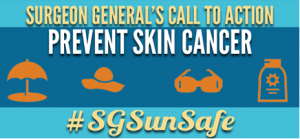Preventing Skin Cancer
Posted on by As the nation’s doctor, I recently launched a Call to Action to Prevent Skin Cancer to address the rising rates of skin cancer in the U.S. While nearly 5 million people are treated for skin cancer each year in the U.S., with an annual cost of $8.1 billion, most cases are preventable. Although people with lighter skin are at higher risk, anyone can get skin cancer—and it can be disfiguring, even deadly. Sunburned and even tanned skin is damaged skin that can lead to skin cancer. That’s why this message is extremely important for individuals whose jobs require them to work outdoors.
As the nation’s doctor, I recently launched a Call to Action to Prevent Skin Cancer to address the rising rates of skin cancer in the U.S. While nearly 5 million people are treated for skin cancer each year in the U.S., with an annual cost of $8.1 billion, most cases are preventable. Although people with lighter skin are at higher risk, anyone can get skin cancer—and it can be disfiguring, even deadly. Sunburned and even tanned skin is damaged skin that can lead to skin cancer. That’s why this message is extremely important for individuals whose jobs require them to work outdoors.
I started my U.S. Public Service career at NIOSH, and later trained as a dermatologist establishing a NIOSH occupational skin disease research program. Being a guest author for this NIOSH Science Blog is a great opportunity to address the importance of sun safety for outdoor workers.
These workers often don’t have the option of staying out of the sun during the hottest time of the day, a primary prevention strategy for limiting exposure to ultraviolet radiation (UV) radiation. Exposure to UV radiation in sunlight is a major cause of skin cancer, and it is the most preventable cause. However, there are other effective steps that employers and workers can take to help protect workers from exposure to UV radiation and skin cancer.
Recommendations for Employers
Employers should take the following steps to protect workers from exposure to UV radiation:
- When possible, avoid scheduling outdoor work when sunlight exposure is the greatest.
- Provide shaded or indoor break areas.
- Provide training to workers about UV radiation including:
- Risks of exposure
- Prevention of exposure
- Signs and symptoms of overexposure.
Recommendations for Workers
Workers should follow these recommendations to protect themselves from UV damage:
- Wear a broad spectrum sunscreen with a minimum of SPF 15.
- SPF refers to the sun protection factor or the length of time that a person will be protected from a burn. An SPF of 15 will allow a person to stay out in the sun 15 times longer than they normally would be able to stay without burning. The SPF rating applies to skin reddening and protection against UVB exposure.
- SPF does not refer to protection against UVA. A broad spectrum sunscreen provides protects against both UVA and UVB rays.
- Sunscreen performance is affected by wind, humidity, perspiration, and proper application.
- Follow the application directions on the sunscreen bottle.
- Sunscreens should be liberally applied (a minimum of 1 ounce) at least 20 minutes before sun exposure.
- Special attention should be given to covering the ears, lips, neck, tops of feet, and backs of hands.
- Sunscreens should be reapplied at least every 2 hours and each time a person gets out of the water or perspires heavily.
- Some sunscreens may also lose efficacy when applied with insect repellents, necessitating more frequent application when the two products are used together.
- Old sunscreens should be thrown away because they lose their potency after 1-2 years.
- Another effective way to prevent sunburn is by wearing protective clothing.
- Dark clothing with a tight weave is more protective than light-colored, loosely woven clothing.
- High-SPF clothing has been developed to provide more protection for those with photosensitive skin or a history of skin cancer.
- Workers should also wear wide-brimmed hats and sunglasses. Sunglasses with 100% UV protection and side panels to prevent excessive sun exposure to the eyes are recommended.
More information on protecting workers from UV radiation can be found on the NIOSH UV Radiation topic page and the NIOSH Fast Facts: Protecting Yourself for Sun Exposure (PDF). Help put an end to the rising rates of skin cancer in the U.S. Employers and workers have a role to play in preventing exposure to UV radiation. Remember, tanned skin is damaged skin.
Read the Call to Action (PDF) to learn about recommended strategies for individuals, communities, policymakers, and state and federal government to reduce skin cancer-related illness, deaths, and healthcare costs.
Join our social media campaign and help us spread the message about skin cancer prevention though our Thunderclap on August 14, 2014 at noon.
Rear Admiral (RADM) Boris D. Lushniak, M.D., M.P.H.
Acting Surgeon General
Posted on by

